As a nursery or childminder, you play a central role in feeding babies and establishing healthy eating habits from an early age. You can also provide families with encouragement and support throughout their baby’s weaning journey and help to achieve a consistent approach to weaning at nursery and home. Read on to find out more about weaning babies at nursery.
Weaning Recommendations
The recommended age to introduce solid foods is from around 6 months (opens in new tab), when baby is showing signs that they’re developmentally ready.
- Firstly, they will be able to sit up unaided and hold their head steady. Babies need to be able to do this so that they can swallow food and eat safely
- They’ll be able to coordinate their eyes, hand and mouth, meaning they can look at food, pick it up and put it to their mouth. Having this co-ordination means they’re more likely to develop the skills needed to take food into their mouth, move it around and swallow safely
- They’ll be able to swallow food and be less likely to spit the food out (although be mindful it’s difficult to spit out very smooth runny foods). To eat solid foods, babies need to move the food from the front of the tongue to the back, so they can swallow it safely.
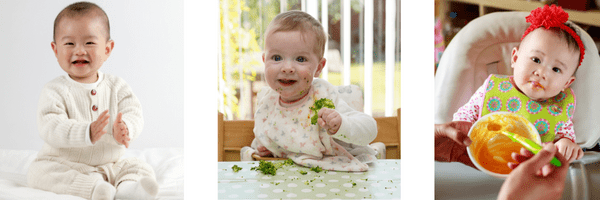
Starting Solid Foods from 6 Months
For babies in your setting who’ve just turned 6 months, it’s important to communicate with parents and understand what foods their baby has been introduced to at home. First foods can include a wide variety of unprocessed foods from the four main food groups.
Babies can quickly move through a range of tastes and textures, meaning you don’t need to wait until they have tried all foods at home first before introducing them to it in your setting. In fact, your early years setting provides the perfect opportunity for babies to learn about a range of tastes and textures through exposure and role modelling.
Vegetables:
Evidence shows us that babies introduced to single vegetable flavours over the first few days are more accepting of vegetables in meals later on. It can be useful to start with savoury vegetables flavours such as broccoli, cauliflower and spinach.
Once babies become familiar with individual tastes they can then try different combinations. They don’t need to try all foods on their own first, it’s fine to start to combine flavours after about the first week or so.

Starchy:
Starchy foods are perfect to include alongside vegetables. Babies can be offered foods like rice, porridge (you don’t need to buy the baby varieties) and cereals, such as ready break and weetabix.

Fruit:
Once baby has accepted savoury tastes, they can be introduced to fruit. You may find that they’re more readily accepting of fruits, compared to vegetables, as they tend to have a preference for sweet tastes!

Protein:
Around 6 months you can also start to include some protein foods into babies diets. For example, foods like beans and pulses, meat, fish and eggs. When offering meat and fish, just make sure the bones are removed and it doesn’t contain any gristle.

Resources:
You can find lots of great recipes ideas from the following evidence-based resources.
- Better Health Start for Life (opens in new tab)
- First Steps Nutrition Trust (opens in new tab)
- Early Start Nutrition (opens in new tab)
Weaning Babies at Nursery- A Note on Foods to Avoid
It’s important to know what foods and drinks are not safe for babies. You can find details on the foods to avoid from Better Health Start for Life (opens in new tab).
What about Food Allergies?
Allergen foods can be introduced from around 6 months (opens in new tab) as part of babies diets, just like any other foods. The foods that are more commonly associated with allergies include:
- cows’ milk (in cooking or mixed with other food)
- eggs
- foods that contain gluten, including wheat, barley and rye
- nuts and seeds (serve them crushed or ground)
- soya
- shellfish (do not serve raw or lightly cooked)
- fish.

The guidance for introducing allergens is to do so one at a time, in very small amounts and on a day when baby is well, as this will help in spotting any kind of reaction/s.
Once introduced and if tolerated, keep offering those foods as part of baby’s usual diet (to minimise the risk of allergy).
At registration in your setting it’s important to check with families if they’ve introduced their baby to the above allergens. You can find more guidance on managing allergies in your setting by taking a look at our blog ‘Dietary Requirements and Allergy Management in your Early Years Setting’ (opens in new tab).
And of course, if parents suspect their child has an allergy, or if they have any questions related to allergies, it’s always best for them to speak to a healthcare professional, such as their GP or Health Visitor, for further advice and support.
What Textures Can Be Offered at Mealtimes?
All babies will have different experiences with food textures. This means it’s important to check each babies stages of development, and support them to experience a range of different textures in your early years setting.
We know that some babies will happily eat finger foods and mashed foods from the beginning, and progress quickly to a range of tastes and textures. While other babies may progress more slowly and start off on smooth foods given on a spoon and gradually start to have finger foods. We also know that some parents prefer to follow a baby-led weaning approach (which refers to offering mainly finger foods) rather than spoon feeding and some families do a bit of both.
There really is no right or wrong way and families should be guided by their baby. The most important thing is that babies are supported to eat a wide variety of foods and given the opportunity to move onto mashed foods and other textures as they become more confident eaters.

Communication with parents is key in supporting them to continue to move through a range of textures with their baby. Some families can be worried about the transition from smooth to lumpy textures, as they’re concerned about how their baby will cope.
- Remember that up until we start offering solid foods, most babies have only consumed milk (a liquid with no lumps!), so this stage of introducing lumps in their food is really important to help babies get used to new textures
- Give babies a spoon and encourage them to try feeding themselves
- Try to support families to move their baby on to mashed and finger foods (from purées or blended) as soon as they’re ready, as it’s important they learn how to bite and chew!
When preparing foods for babies it’s important to ensure the size, shape and texture of foods are suitable for children’s abilities. You can find more guidance in our blog ‘‘Preparing Food Safely to Reduce the Risk of Choking’ (opens in new tab).
Infants and young children should be seated safely in a highchair, or appropriately sized low chair, while eating. Infants and young children should never be left alone while they’re eating, and staff in your setting should be familiar with paediatric first aid advice so they can assist children if they get into any difficulty.
The criteria for effective Paediatric First Aid (PFA) training can be found in the Statutory framework for the early years foundation stage (opens in new tab), Annex A.
Weaning Babies at Nursery- How Much to Offer
At first, babies don’t need 3 meals a day (they only have small little tummies), so it’s best to start by offering them small amounts of food (just a few pieces, or teaspoons of food) and starting off once a day. Remember that milk will continue to provide babies with the majority of their energy and nutrients when foods are first introduced.
The amount of food babies are offered can gradually be increased over the first few weeks. There are no set portion sizes or recommended number of teaspoons of food that babies should eat. It’s important that you’re guided by each babies individual appetite and stop when they show signs they’ve had enough.
Around 7 to 9 month’s, babies will gradually move towards eating 3 meals a day (breakfast, lunch and tea). Offering them a wide variety of different foods is important to help ensure that they get enough energy and nutrients (such as iron).

Around 10 to 12 months, babies should be used to having 3 meals a day (breakfast, lunch and tea), in addition to their milk feeds. Lunch and tea can include a main course and a nutritious pudding, such as fruit or unsweetened yoghurt.

A Note on Snacks
Babies under 12 months don’t need snacks! If you think a baby is hungry in-between meals, offer extra milk feeds instead.
A Note on Milk
When solid foods are first introduced around 6 months, milk is still very important. This is because babies will still be getting most of their energy and nutrients from breast milk or first infant formula. At the beginning, how much babies eat is less important than getting them used to the idea of eating.
- The initial stages in particular are really about exposing babies to new foods and practising how to manage foods in their mouth!
- It’s important to continue to offer babies their usual milk (breast milk or formula milk) alongside their first foods and in response to their cues
- Remember that babies tummies are tiny and fill up quickly – so offer milk feeds after solid foods.
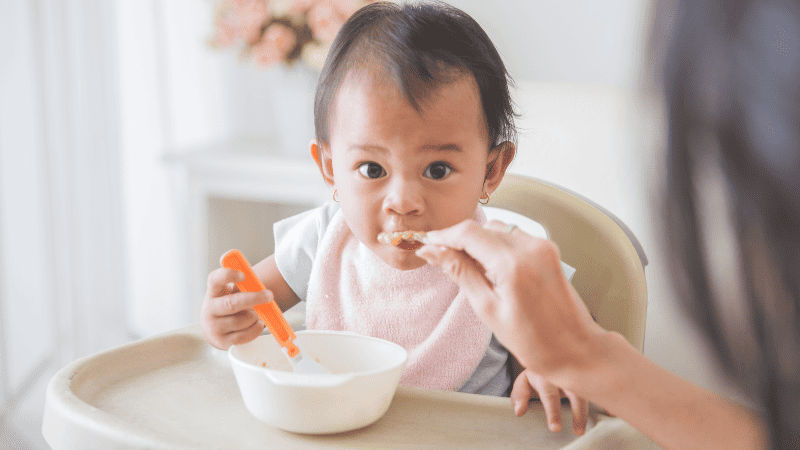
Around 7-9 months
Alongside their meals, babies are likely to have around four milk feeds a-day (for example, on waking, after lunch, after tea and before bed), but of course do continue to feed them in response to their cues.
- If families offer breast milk, they’ll likely find that their baby adapts their milk intake as their food intake increases
- If families offer formula milk, their baby will around 600mls of milk a- day (this is just a guide).
Around 10-12 months
Babies may have about 3 milk feeds a day, for instance: after breakfast, after lunch and before bed.
- Again, breastfed babies will likely adapt their milk consumption as their food intake changes.
- As a guide, babies fed infant formula will drink about 400ml daily.
For guidance on the safe preparation of first infant formula, see more information in this Start for Life booklet (opens in new tab)
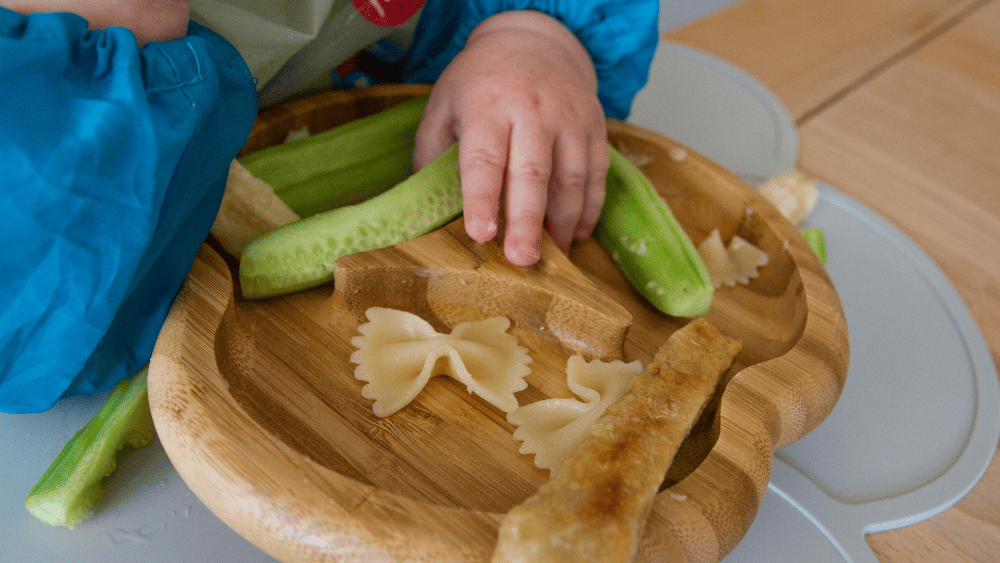
Safe Weaning
In your setting there must be an area which is adequately equipped to provide healthy meals, snacks and drinks for children, as necessary.
There must be suitable facilities for the hygienic preparation of food for children, if necessary including suitable sterilisation equipment for babies’ food.
You must be confident that those responsible for preparing and handling food are competent to do so.
In group provision, all staff involved in preparing and handling food must receive training in food hygiene.

Example Weaning Menu
We’ve created some example weaning menus that you may find useful when creating menus for under 1’s in your setting.
Click here to open our example weaning menus (PDF, 536kb).

Weaning Equipment
We’ve put together a handy blog providing information around ‘Weaning Equipment’ (opens in new tab), which covers our top tips around:
- Safe and suitable seating
- Choosing suitable bowls and spoons
- Choosing suitable cups
- Items you’ll need when preparing different food textures.
It’s important that babies feeding equipment is kept clean as babies immune systems are not fully mature. This means their more likely to become ill if they’re exposed to harmful bacteria.
To reduce exposure to harmful bacteria, it’s important to:
- Wash your hands before preparing food, and babies hands if they’re feeding themselves
- Wash equipment such as chopping boards, bowls and spoons in hot soapy water
- Clean and disinfect babies highchairs and bibs after each meal
- Regularly clean cloths and sponges, as they can harbour a lot of bacteria
- Continue to sterilise bottles, teats and bottle attachments until babies are at least 12 months old (or for along as they’re using them), regardless of whether you’re offering babies expressed breast milk or formula milk. Teats and screw tops of bottles are more difficult to clean and can trap harmful bacteria that could make baby ill.
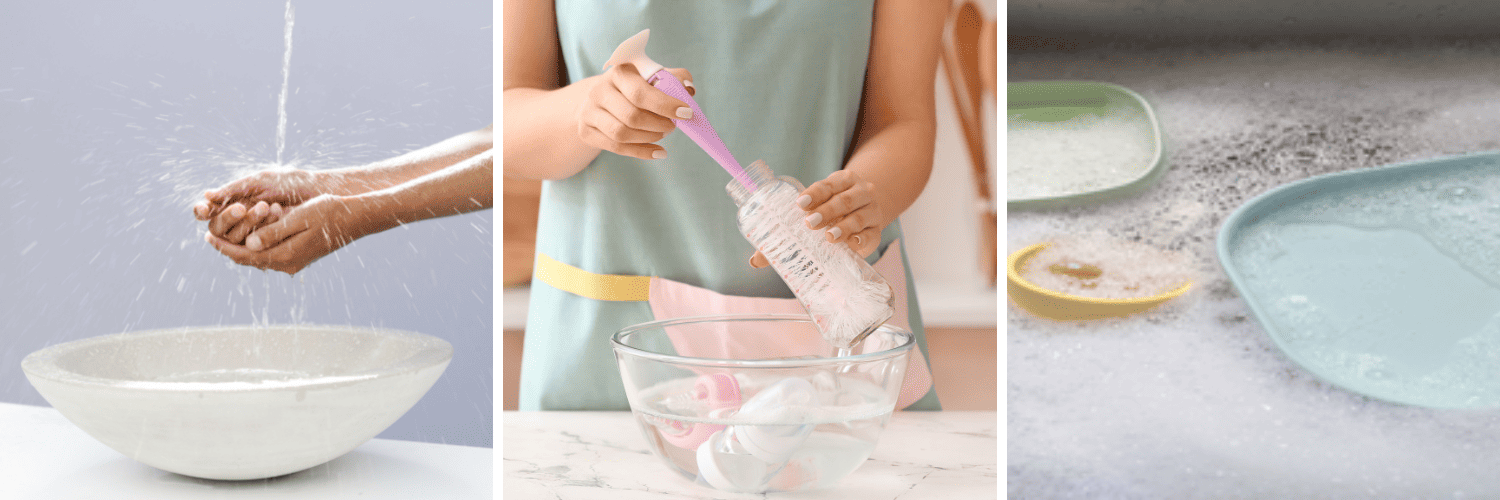
Resources
For more detailed support on nutrition requirements from birth to 12 months, complete our Food and Nutrition for Infants (opens in new tab) training, specially designed for early years staff.
We’ve also develop a blog ‘Feeding Baby at Nursery’ (opens in new tab) with a comprehensive overview of how to develop your infant feeding policy!
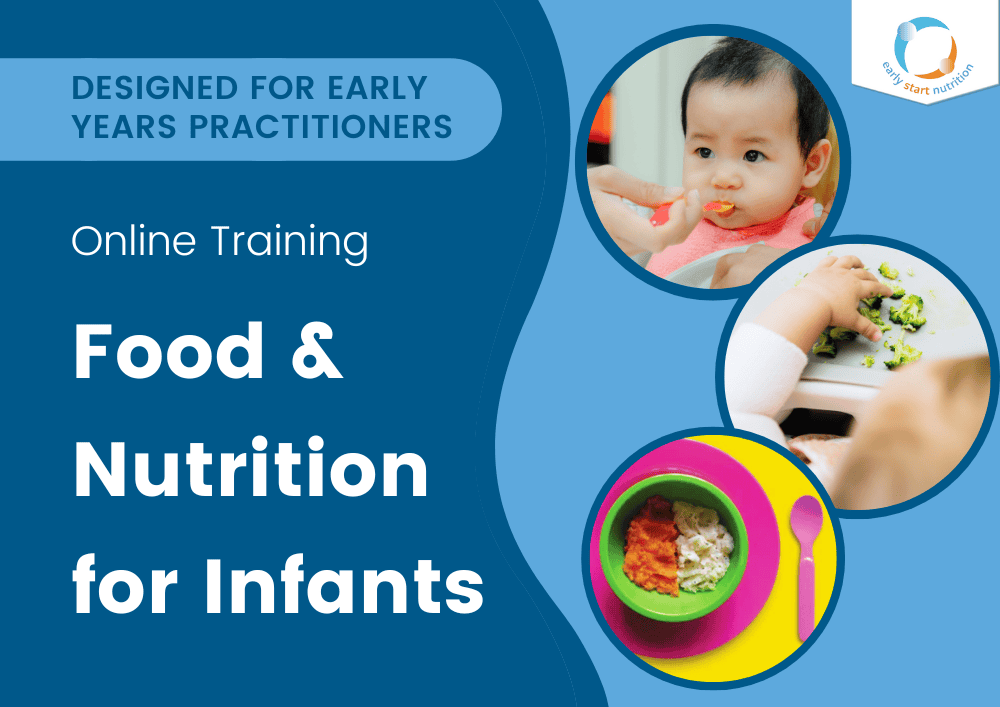
Resources for Parents
Here at Early Start we have lots of ideas to support families, whether it’s recipe ideas or answers to nutrition questions, families can rely on our team of expert Registered Nutritionists.
You can signpost families to our FREE:
- Monthly Webinars
- Online nutrition courses
Please signpost families to our Nutrition for Parents page here!

I learned when a baby should start eating solid food, what foods should be avoided. Sugar and and salt must be avoided three years. Any sugary drinks must be avoided. Food must be prepared safely for babies.
This session was very good thank you.
-food need to be rich in energy and nutrients for activity ,growth, normal development.
-starting complimentary food at 6 months of age
-infant should eat a variety of food from the four food groups including fruits, vegetables, starchy food and protein.
-feed infants slowly and patiently encourage them to eat but don’t force them, and maintain eye contact
-start with small amount of food and increase gradually as the infant get older.
-avoid foods that may cause choking such as raw carrots or whole grapes